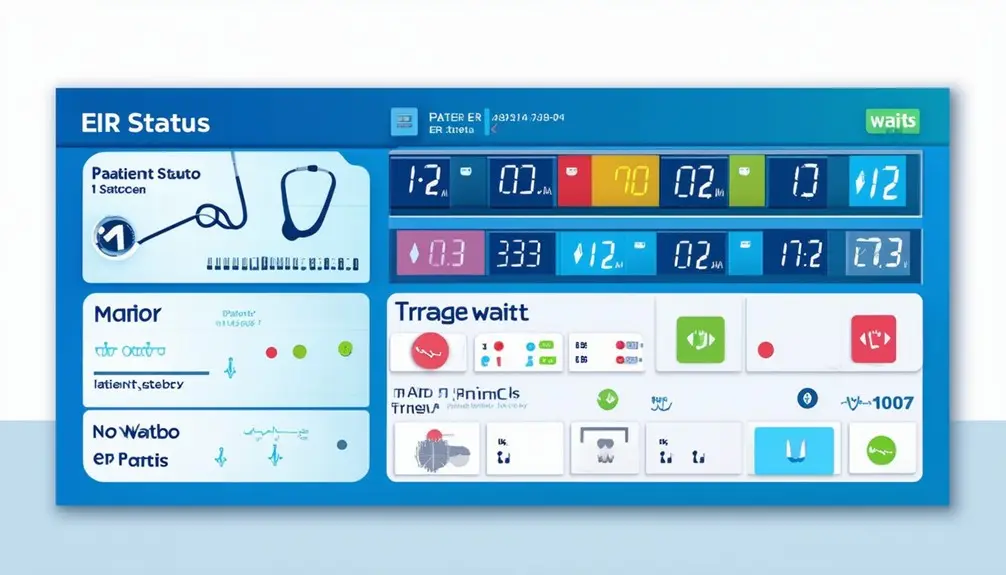Real-time updates on ER status boards are essential for effective emergency department management. You'll see current patient flow, room availability, and critical alerts, aiding quick, informed decisions. These updates reduce wait times and improve patient satisfaction. Status boards should be updated frequently, reflecting real-time conditions to make sure accurate resource allocation. Key details like patient names, medical conditions, and urgency levels are displayed, helping staff prioritize care. Enhanced coordination among healthcare teams results in better patient outcomes. Accurate, real-time data also streamlines billing and coding, boosting financial health. Stay tuned for more on optimizing ER efficiency and revenue management.
Key Takeaways
- Real-time updates enhance decision-making and resource allocation in emergency departments.
- Live data on patient flow, room availability, and critical alerts optimize ER operations.
- Continuous updates ensure accurate patient conditions, admissions, discharges, and transfers are reflected.
- Electronic status boards with color coding facilitate quick identification of critical patients.
- Frequent updates improve billing accuracy by capturing all services provided and ensuring precise code modifications.
Importance of Real-Time Updates

Real-time updates on ER status boards are crucial for timely decision-making and efficient resource allocation in emergency departments. You need current information on patient flow, room availability, and critical alerts to manage an effective ER. Immediate updates help you make quick decisions, prioritize patient care, and allocate resources where they're most needed.
When you have access to live updates on ER status boards, communication among healthcare teams improves significantly. This improved communication leads to better coordination of care, ensuring everyone is on the same page. Real-time data can also reduce wait times, which, in turn, enhances patient satisfaction and optimizes overall emergency department operations.
Moreover, timely updates enable you to respond swiftly to emergencies, track patient progress, and ensure smooth transfers between care units. This means you can address critical situations promptly, improving outcomes and maintaining high standards of care. Essentially, real-time updates on ER status boards are a cornerstone for an efficient, responsive, and patient-centered emergency department. By leveraging these updates, you can make informed decisions that ultimately lead to better patient outcomes and streamlined operations.
Frequency and Timing of Updates

You should update ER status boards quarterly to guarantee they reflect the latest patient data and resource allocation. Timely updates allow staff to access accurate information, enhancing decision-making and patient care. Regular updates streamline communication and improve overall efficiency in the ER.
Quarterly Update Schedule
Unlike the quarterly OPPS updates, ER status boards are continuously refreshed to maintain up-to-the-minute accuracy. The real-time nature of these updates is vital for reflecting current patient conditions, admissions, discharges, and transfers. You won't find these updates tied to a quarterly schedule; instead, they occur as frequently as the emergency department's activity demands.
The frequency of updates depends on several factors, including patient volume, acuity levels, and overall workflow. When patient conditions change rapidly or new patients arrive, the ER status board updates immediately to make sure that healthcare staff are working with the most current information available.
This continuous updating process helps optimize patient flow and resource allocation. Real-time updates make sure that medical staff can respond promptly to critical situations and make informed decisions. Efficient communication within the emergency department is another benefit, as everyone relies on the status board for accurate, up-to-date information.
Timely Information Access
Keeping ER status boards updated in real-time or at frequent intervals is vital for providing accurate and timely information to healthcare staff and patients. You'll find that regular updates help streamline patient flow, optimize resource allocation, and enhance communication within the emergency department.
When ER status boards are updated promptly, patient satisfaction improves. Shorter wait times and proper triaging of cases guarantee that patients receive the care they need without unnecessary delays. You'll see that live updates empower healthcare providers to make informed decisions quickly, improving the overall efficiency of patient care management.
Consistent monitoring and updating of ER status boards are essential for maintaining efficiency, transparency, and quality of care. By keeping the information current, you can make certain that all team members are aware of the latest developments, allowing for a more coordinated approach to patient care.
Ultimately, timely updates on ER status boards aren't just about maintaining order—they're about providing the highest level of care. With real-time information, you'll be better equipped to handle the dynamic environment of an emergency department, ensuring every patient receives the attention they deserve.
Key Information Displayed

ER status boards prominently exhibit patient names, room numbers, medical conditions, and treatment status to facilitate efficient and effective healthcare delivery. This information allows healthcare staff to track patient flow, prioritize care, and communicate effectively. It's critical to know who's being treated, who's waiting, and who's ready for discharge.
By including details such as medical conditions and treatment status, staff can make quick decisions about patient care. Color coding or symbols are often used to indicate the urgency of cases, helping staff identify critical patients at a glance. For example, a red symbol may signify an emergency, while green might indicate a patient is prepared for discharge.
Electronic ER status boards offer the advantage of real-time updates, ensuring all providers have access to the most current information. This immediacy reduces the risk of miscommunication and helps coordinate care more seamlessly. When new information is available, the board updates automatically, keeping everyone on the same page. Real-time data guarantees that patient statuses are accurately reflected, allowing for timely and appropriate medical interventions.
Addendum A and B Insights
While ER status boards streamline patient management, Addendum A and B provide the essential financial details to guarantee healthcare facilities receive accurate reimbursement for outpatient services. These addenda contain detailed information on HCPCS codes, status indicators, APC groups, and payment rates. Updated quarterly, they reflect changes in the Outpatient Prospective Payment System (OPPS), securing you stay current with the latest guidelines.
Access to Addendum A and B is pivotal for understanding OPPS payment rates. This secures your services are reimbursed correctly, directly impacting your facility's revenue cycle management. Each update captures quarterly OPPS pricer changes, which influence the payment rates for various outpatient services.
Impact on Billing and Coding
By using live updates on ER status boards, you can make real-time code modifications that impact billing accuracy. ER billing adjustments become more straightforward, ensuring you capture every service provided. This leads to precise payment calculations and ideal revenue management.
Real-time Code Modifications
Real-time code modifications guarantee patient records are always accurate and up-to-date, directly impacting billing and coding efficiency. By capturing changes to services provided promptly, you streamline the billing process and reduce errors. This ensures that modifications are reflected immediately, leading to more precise coding and appropriate reimbursement for services rendered.
Accurate and timely code modifications are essential for maintaining compliance with coding guidelines and maximizing revenue. When ER status boards are updated in real-time, the overall efficiency of the billing and coding workflow in emergency departments improves significantly. This not only enhances the accuracy of patient records but also supports the financial health of healthcare facilities.
Here's a quick overview of the key benefits:
| Benefit | Description | Impact on Billing and Coding |
|---|---|---|
| Accuracy | Ensures patient records are up-to-date | Reduces billing errors |
| Compliance | Maintains adherence to coding guidelines | Avoids regulatory issues |
| Efficiency | Streamlines the billing process | Speeds up reimbursement |
| Revenue Maximization | Captures all services provided | Enhances financial health |
Using real-time updates on ER status boards, you can improve your emergency department's workflow, ensuring that both patient care and administrative tasks are handled with precision and efficiency.
ER Billing Adjustments
ER billing adjustments hinge on the dynamic updates provided by status boards, directly influencing how coding professionals capture and bill for services. Real-time updates on patient status and treatment progress are essential. As patient conditions evolve, so do the necessary procedures and resources, which require prompt and precise billing adjustments.
Accurate coding in the ER is vital for proper reimbursement. When you monitor live updates on ER status boards, you stay informed about changes that may affect billing and coding practices. This guarantees that the services provided and the level of care required are accurately captured.
Here's how live updates impact billing and coding:
- Procedure Changes: If a patient's status changes, additional or different procedures may be required. Real-time updates guarantee these are captured and billed correctly.
- Resource Utilization: Knowing exactly what resources are used in real-time helps in accurate billing. For instance, if additional imaging or lab tests are conducted, you can adjust the billing codes accordingly.
- Condition Fluctuations: Patient conditions can rapidly change. Immediate updates allow you to adjust coding to reflect the level of care provided, ensuring accurate reimbursement.
Accurate Payment Calculations
Ensuring precise payment calculations depends on the live updates provided by status boards, directly impacting billing and coding practices. Live updates guarantee you're working with the most current information, which is essential for accurate billing. This real-time data helps you avoid errors that could lead to payment discrepancies, maximizing revenue for your healthcare facility.
Understanding the impact of these updates on billing and coding can't be overstressed. With timely updates, you streamline the billing process, reducing the risk of miscalculations that can arise from outdated or incorrect information. Accurate information on ER status boards allows coding professionals to guarantee compliance with regulations, safeguarding against potential audits and penalties.
For coding professionals, access to live updates is necessary. It helps in precise reimbursement, reflecting the most recent patient status and services rendered. This is particularly important in high-turnover settings like ERs, where patient information can change rapidly. By keeping the data current, you improve the accuracy of coding, which directly influences the financial health of the facility. To summarize, live updates on ER status boards are essential for maintaining precise payment calculations, ensuring both regulatory compliance and optimal revenue management.
Accessing the Latest Updates
You can quickly access the latest updates on patient statuses and room availability by checking the digital ER status board. This tool offers real-time updates, ensuring you stay informed about patient flow and wait times. The digital displays or electronic boards are essential for maintaining an efficient emergency department.
To fully utilize the ER status board, follow these steps:
- Regularly Check for Updates: Consistently monitor the board to stay aware of any changes in patient status or room availability. This helps you manage patient flow effectively.
- Understand Color-Coded Systems: Familiarize yourself with the color-coded systems or symbols used on the board. These visual cues quickly inform you about the condition and priority of patients.
- Ensure Timely Updates: Staff should be trained to promptly update the board to maintain accuracy. This minimizes communication errors and enhances operational efficiency.
Automated notification systems integrated with the ER status board can alert staff to critical changes, ensuring immediate action when necessary. These systems streamline communication and help maintain a smooth workflow. By leveraging these digital tools, you can enhance patient care and improve overall departmental efficiency.
Frequently Asked Questions
How Do ER Status Boards Integrate With Existing Hospital Management Systems?
You'll find ER status boards integrate seamlessly with hospital management systems through APIs. They pull real-time data on patient status, bed availability, and staff assignments, enhancing workflow efficiency and patient care coordination.
Are ER Status Boards Accessible to Patients and Their Families?
You might worry about privacy, but ER status boards are accessible to patients and their families while ensuring confidentiality. You can check wait times and updates without compromising sensitive information, making your experience more transparent and informed.
What Security Measures Protect Patient Information on ER Status Boards?
You're probably wondering about security measures for patient information on ER status boards. Hospitals use encrypted systems, access controls, and regular audits to protect data, ensuring only authorized personnel can view sensitive patient information.
Can ER Status Boards Be Customized for Different Departments?
Yes, you can customize ER status boards for different departments. Tailor the layout, information fields, and alerts to meet specific departmental needs, ensuring efficient workflow and clear communication within each specialized area.
What Training Is Required for Staff to Use ER Status Boards Effectively?
To use ER status boards effectively, you need basic computer skills and specific training on the software interface. Training typically includes using the system, updating patient information, and understanding status indicators to guarantee accurate, real-time data management.
Conclusion
Imagine the relief as you glance at the ER status board, updated in real-time, and see your loved one's status. These timely updates don't just inform; they streamline care, optimize billing, and enhance coding accuracy. You're not left in the dark, wondering. Instead, you get clarity, instantly. This transformation in communication means better decisions and faster treatments. Stay connected, stay informed, and let the latest updates guide you through the ER chaos.





